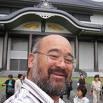Chapter 3: Simile and Parable
[Hiyu]
The fifth volume of the Hokke Mongu
states, "The Buddha's great compassion is never exhausted, his skillful wisdom operates without limit. That is why the
Buddha preaches parables. Moving the trees, he shows us the wind; raising his fan, he reveals the moon. This is how he awakens
us to the truth." The [Buddha's] 'great compassion' is like the mercy and compassion that a mother feels for her
child. As Chang-an states, 'One who rids the offender of evil is acting as his parent.' (Gosho Zenshu p. 721)
The sutra states, "At that time, Shariputra's
mind danced with joy. Then he immediately stood up, pressed his palms together, gazed up in reverence at the face of the World
Honored One." (LS p. 47, 3LS p. 77)
'Shariputra' represents
the physical and spiritual activities of all persons in the ten worlds. Now Nichiren and his disciples who chant Nam Myoho
Renge Kyo are all Shariputras. One 'dances with joy' when one comes to the realization that the phenomena of
the body and mind are the Mystic Law. 'Pressing' refers to myo or Mystic, while 'palms' refer to ho
or the Law. 'Together' means the 'world of Buddhahood' and 'palms' mean the other nine worlds. (Gosho Zenshu
p. 722)
The sutra states, "But now I have
heard from the Buddha what I never heard before, a Law never before known in the past, and it has ended all my doubts and
regrets. My body and mind are at ease and I have gained a wonderful feeling of peace and security." (LS p. 48, 3LS
p. 78)
'I have heard from the Buddha' refers
to the disciples of Nichiren. This passage explains the doctrines of 'threefold contemplation in a single mind' and the 'three
thousand realms in a single moment of life' whereby we attain Buddhahood in our present form. Provisional teachings offer
neither ease nor peace. According to the orally transmitted teachings, 'my body and mind are at ease' indicates the
principle of 'earthly desires are enlightenment' and the 'sufferings of birth and death are nirvana.' 'Body' here indicates
that the sufferings are nirvana and 'mind' that 'earthly desires are enlightenment.' The joy of mouth is chanting Nam
Myoho Renge Kyo. The joy of mind arises from the elimination of the obstacle of darkness. (Gosho Zenshu p. 723)
The sutra states, "When I heard the
sound of this Law." (LS p. 50, 3LS p. 80)
'Hearing' means to take
faith in the Lotus Sutra and 'a voice' indicates the voice and sound [i.e. rhythm] of all phenomena, which signifies
the Mystic Law. Regarding this 'voice,' the fourth chapter says 'we will take the voice of the Buddha way
and cause it to be heard by all.' 'All' means human beings living in the phenomenal world, and 'voice' means
Nam Myoho Renge Kyo. (Gosho Zenshu p. 723)
The sutra states, "This house has
only one gate." (LS p. 56, 3LS p. 86)
Chapter Five of the Hokke Mongu states,
'This house has only one gate' serves to illustrate [the meaning of] the earlier passage 'by means of various teachings,
I declare the Buddha way.' This gateway, moreover, has two meanings. It is also the gateway out from the house and [also]
the gateway to the cart. The house represents birth and death, while the gateway is the essential path of exit. [From this
view,] it represents the conclusion of the provisional teachings. The cart is the teaching of the Mahayana. The gateway
[viewed as opening into the Mahayana] represents the conclusion of the perfect teaching.
The 'one gate' [leading
out of the burning house] means faith in the Lotus Sutra. The [great white ox] cart indicates the Lotus Sutra itself.
The ox represents Nam-myoho-renge-kyo. The [burning] house represents earthly desires. [Mounting the
great white ox cart,] we travel the cycle of birth and death secure upon the earth of our inherent enlightened nature. (Gosho
Zenshu p. 724)
The five elements that make up the bodies
of living beings, such as we, are reflections of Myoho Renge kyo, and therefore we should use this Treasure Tower chapter
as our mirror. (Gosho Zenshu p. 724)
The sutra Chapter states, "[The children
will find constant enjoyment] in mounting this jeweled vehicle and proceeding directly to the place of practice."
(LS p. 71, 3LS p. 100)
Embracing the Lotus Sutra is
called 'proceeding directly to the place of practice. [wisdom throne]' It is not the case that he [votary] leaves his
present place and goes elsewhere. Now the dwellings of Nichiren and his disciples who chant Nam Myoho Renge Kyo, whether
in the mountains, valleys or the wide plains, is in every case the Land of Tranquil Light. (Gosho Zenshu p.
781)

